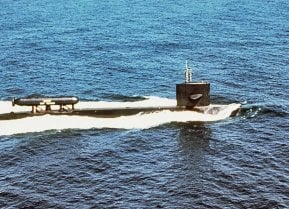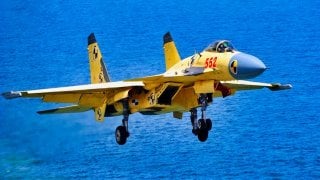China's J-15 Aircraft Carrier Fighter Plane Has Strange Origin: Ukriane
After failed attempts to procure Russia's Sukhoi Su-33—due to disputes over intellectual property and procurement terms—China reverse-engineered the Su-33 using a prototype obtained from Ukraine, leading to the development of the J-15.
3 Key Facts: The Shenyang J-15 "Flying Shark" is China's carrier-based multirole fighter, serving with the People's Liberation Army Navy. With around 60 units built, it underscores China's expanding naval capabilities in the Indo-Pacific region.
-After failed attempts to procure Russia's Sukhoi Su-33—due to disputes over intellectual property and procurement terms—China reverse-engineered the Su-33 using a prototype obtained from Ukraine, leading to the development of the J-15.
-Initially powered by Russian engines, the J-15 now uses China's WS-10B engines, claimed to offer better performance. While China asserts the J-15 outperforms the U.S. F/A-18 Super Hornet in certain aspects, these claims are debated. Regardless, the J-15 symbolizes China's growing military ambitions.
J-15 Flying Shark: China's Reverse-Engineered Carrier Fighter from Ukraine
Known as the Flying Shark, the Shenyang J-15 is a carrier-based multirole fighter currently in service with the People’s Liberation Army Navy. The J-15, of which sixty have been built, is further indication of China’s commitment to expanding its naval capabilities as she continues to assert herself more forcefully throughout the Indo-Pacific.
Russian friction
China spent years working to procure a carrier-based fighter from the Russians, the Sukhoi Su-33. The bid failed, as Moscow tells the story, when Russia learned that China had ripped off the blueprints of another Russian jet, the Sukhoi Su-27SK, to create a Chinese-derivative.
The Su-27SK derivative was known as the J-11B and incited Russia, who claimed that China had violated intellectual property agreements between the two nations. China tells a different story, however; according to China, the Su-33 procurement attempt failed when Russia demanded a minimum order of 50 Su-33s, with a payment sufficient to cover the high cost of reopening the Su-33’s defunct production lines.
He said, she said. Whatever happened, the Chinese moved on from their attempts to buy the Su-33, and instead, the did what they often do: relied on reverse-engineering.
Reverse Engineering
To reverse engineer the Su-33, the Chinese relied upon an Su-33 prototype that had been procured from Ukraine. The result was the J-15, whose prototype debuted in 2009, and made its first ski-jump takeoff in 2010. Granted, the ski-jump wasn’t on a carrier, but rather had been constructed on land, where the stakes were lower, and the margins for error higher, but still, the test served as a proof of concept. The J-15 was tested from an actual aircraft carrier in 2012, during a deployment from the Lianoning.
In addition to the ski-jump takeoffs, the J-15 was outfitted to perform catapult launches, too. As such, the J-15 is built strong, to withstand the structural stress of carrier takeoffs and landings. Still, the J-15’s airframe was built predominantly from composite materials for the purpose of saving weight and improving performance.
Originally, the J-15 had been built with a Russian Saturn AL-31 turbofan engine. But in 2022, the J-15 appeared with a Chinese-made WS-10B engine. According to the Chinese, their homegrown engine was better than the Russian Saturn, offering improved safety, reliability, and service life.
J-15 Performance
The J-15 does perform admirably. While Chinese assessments, that the J-15 “exceeds the aerodynamic capabilities of virtually any fighter aircraft currently operated by regional militaries, except for the U.S. F-22 Raptor,” may be overblown, the J-15 does have a ten percent greater thrust-to-weight ratio, and 25 percent better wing loading, than the closest American equivalent – the F/A-18 Super Hornet. And the Chinese have not been shy about claiming that the J-15 is a superior aircraft to the Super Hornet, at least with respect to bomb load, combat radius, and mobility, if not with respect to electronic and combat systems.
Either way, the J-15 is an indication of China’s budding military ambitions.
About the Author: Harrison Kass, Defense Editor
Harrison Kass is a defense and national security writer with over 1,000 total pieces on issues involving global affairs. An attorney, pilot, guitarist, and minor pro hockey player, Harrison joined the US Air Force as a Pilot Trainee but was medically discharged. Harrison holds a BA from Lake Forest College, a JD from the University of Oregon, and an MA from New York University. Harrison listens to Dokken.
Image Credit: Creative Commons.


